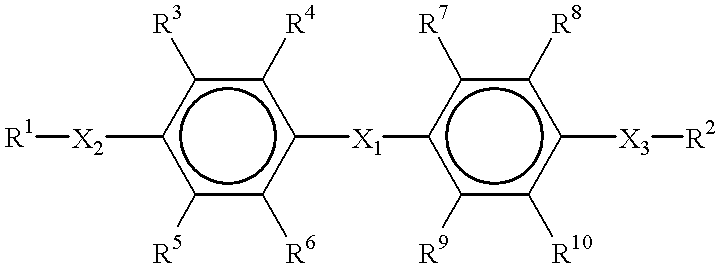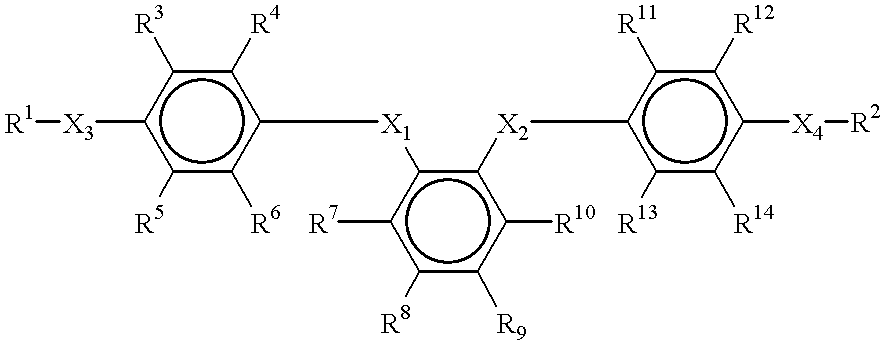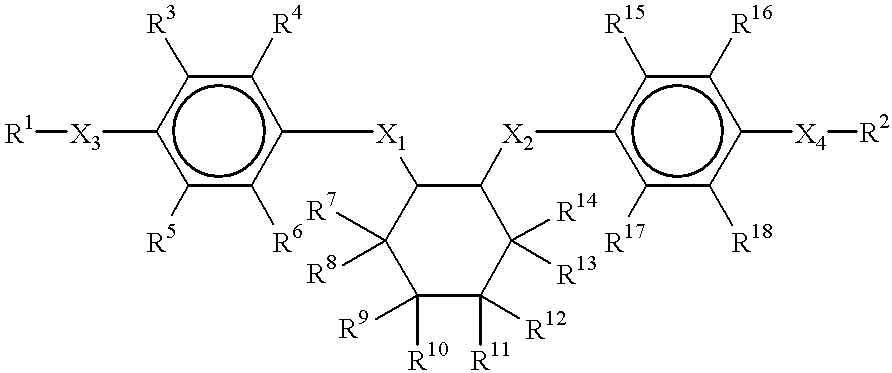Film for optical elements
a technology of optical elements and films, applied in the field of films for optical elements, can solve the problems of reducing the display contrast, affecting the quality of the film, and the film cannot meet all of the above conditions, so as to improve the viewing angle and color compensation, improve the effect, and improve the viewing angl
- Summary
- Abstract
- Description
- Claims
- Application Information
AI Technical Summary
Benefits of technology
Problems solved by technology
Method used
Image
Examples
reference example 1
Using 40 mmols of terephthalic acid, 40 mmols of 2,6-naphthalenedicarboxylic acid, 80 mmols of catechol diacetate, and 80 mmols of acetoxybenzoic acid, polymerization was carried out in a nitrogen atmosphere at 260.degree. C. for 4 hours, at 290.degree. C. for 2 hours, and then at 290.degree. C. for 4 hours in a current of nitrogen gas fed at a rate of 100 ml / min, to afford a liquid crystalline polyester (formula 1). This liquid crystalline polyester had an inherent viscosity of 0.16, had a nematic phase as a crystal phase, and had an isotropic phase--liquid crystal phase transition temperature of not lower than 300.degree. C. and a glass transition point of 120.degree. C.
Using this liquid crystalline polyester, there was prepared a 10 wt % solution thereof in a mixed phenol / tetrachloroethane solution (6 / 4 weight ratio) solvent. This solution was then applied onto a soda glass plate in accordance with a bar coating method, then dried, heat-treated at 190.degree. C. for 30 minutes, a...
reference example 2
Using 10 mmols of 4-octyloxybenzoic acid, 50 mmols of terephthalic acid, 45 mmols of naphthalenedicarboxylic acid, 50 mmols of catechol diacetate, 50 mmols of 3-methylcatechol diacetate, and 50 mmols of 4-acetoxybenzoic acid, a deacetylation polymerization was carried out in a nitrogen atmosphere at 270.degree. for 4 hours, and then at the same temperature for 2 hours in a current of nitrogen gas fed at a rate of 30 ml / min. The resulting reaction product was then dissolved in tetrachloroethane and thereafter purified by reprecipitation with methanol to afford a liquid crystalline polyester (formula 2). This liquid crystalline polyester had an inherent viscosity of 0.10, had a nematic phase as a liquid crystal phase, and had an isotropic phase-liquid crystal phase transition temperature of 240.degree. C. and a glass transition point of 75.degree. C.
Using the liquid crystalline polyester, there was prepared a 10 wt % solution thereof in a mixed phenol / tetrachloroethane (6 / 4 weight rat...
reference example 3
10 mmols of tert-butylhydroquinone diacetate and 20 mmols of 1,6-pentyloxy-2-naphthoic acid were reacted in a nitrogen atmosphere at 250.degree. C. for 4 hours, at 270.degree. C. for 2 hours, and then at 27.degree. C. for 2 hours in a current of nitrogen gas fed at a rate of 30 ml / min. Subsequent recrystallization of the resulting reaction product from a mixed methanol / ethyl acetate (1 / 1) solvent afforded the compound of formula (3).
Formula 3
##STR14##
PUM
 Login to View More
Login to View More Abstract
Description
Claims
Application Information
 Login to View More
Login to View More - R&D
- Intellectual Property
- Life Sciences
- Materials
- Tech Scout
- Unparalleled Data Quality
- Higher Quality Content
- 60% Fewer Hallucinations
Browse by: Latest US Patents, China's latest patents, Technical Efficacy Thesaurus, Application Domain, Technology Topic, Popular Technical Reports.
© 2025 PatSnap. All rights reserved.Legal|Privacy policy|Modern Slavery Act Transparency Statement|Sitemap|About US| Contact US: help@patsnap.com



